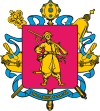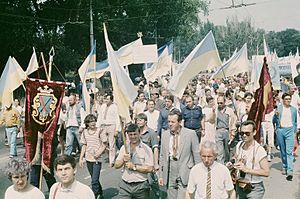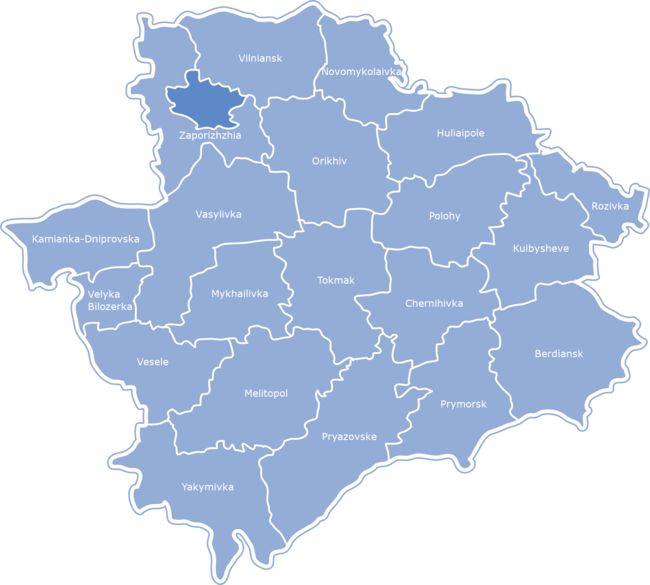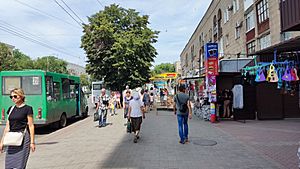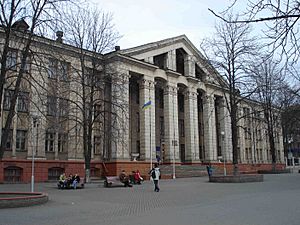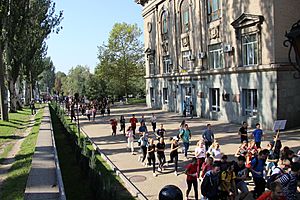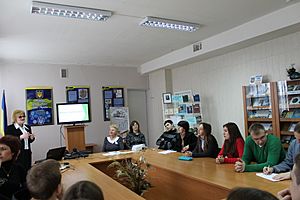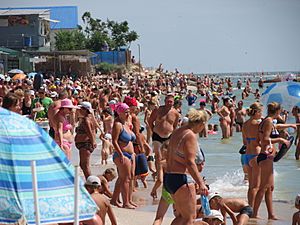Zaporizhzhia Oblast facts for kids
Quick facts for kids
Zaporizhzhia Oblast
Запорізька область
|
|||
|---|---|---|---|
| Zaporizka oblast | |||
|
|||
| Nickname(s):
Запоріжжя (Zaporizhzhia)
|
|||
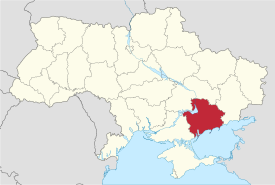 |
|||
| Country | Ukraine | ||
| Administrative centre | Zaporizhzhia | ||
| Area | |||
| • Total | 27,183 km2 (10,495 sq mi) | ||
| Area rank | Ranked 9th | ||
| Population
(2022)
|
|||
| • Total | |||
| • Rank | Ranked 9th | ||
| Demographics | |||
| • Official language(s) | Ukrainian | ||
| Time zone | UTC+02:00 (EET) | ||
| • Summer (DST) | UTC+03:00 (EEST) | ||
| Postal code |
69-72
|
||
| Area code | +380-61 | ||
| ISO 3166 code | UA-23 | ||
| Raions | 5 | ||
| Cities (total) | 14 | ||
| • Regional cities | 5 | ||
| Urban-type settlements | 23 | ||
| Villages | 920 | ||
| FIPS 10-4 | UP26 | ||
| Website | Zoda.gov.ua | ||
The Zaporizhzhia Oblast (Ukrainian: Запорізька область, romanized: Zaporizka oblast), also called Zaporizhzhia, is a region in southeastern Ukraine. Its main city and administrative center is Zaporizhzhia. The region covers about 27,183 square kilometers (10,495 square miles). In 2022, its population was around 1,638,462 people.
This region is very important for Ukraine's factories and farms. Since the 2022 Russian invasion of Ukraine, much of the region, including its coast, has been under Russian military control. However, the capital city and most of the people still live under Ukrainian rule.
On September 30, 2022, Russia announced it had taken over Zaporizhzhia and other Ukrainian regions. Most countries around the world do not recognize this takeover.
To the south, Zaporizhzhia Oblast has about 150 kilometers (93 miles) of coastline along the Sea of Azov. This area is part of a coastal region known as Pryazovia.
Contents
Geography of Zaporizhzhia Oblast
The Zaporizhzhia Oblast covers an area of 27,183 square kilometers. As of 2013, its population was estimated to be 1,785,243 people.
Main Cities in the Region
Some of the important cities in Zaporizhzhia Oblast include:
- Zaporizhzhia (the capital city)
- Melitopol (currently under Russian occupation)
- Berdiansk (currently under Russian occupation)
- Enerhodar (currently under Russian occupation and home to the Zaporizhzhia Nuclear Power Plant)
Land Features and Landscape
Zaporizhzhia Oblast has a mostly flat landscape. The soil is very fertile, mostly chernozem (black earth). Understanding the land is important for farming and using the land well.
While generally flat, the region does have higher and lower areas. The highest part is the Azov Upland in the central-eastern area. This upland stretches into the Donetsk Oblast. To the south, near the Sea of Azov, is the Azov coastal plain.
History of the Region
Long ago, the area of modern Zaporizhzhia Oblast was known as Gerrhos, according to Herodotus. It was a burial place for the kings of the "Royal Scythians".
The current Zaporizhzhia Oblast was officially created on January 10, 1939. It was part of the Ukrainian Soviet Socialist Republic at that time.
In 1991, during the vote for Ukraine's independence, 90.66% of people in Zaporizhzhia Oblast voted for Ukraine to be a free country.
Recent Events: Russian Invasion
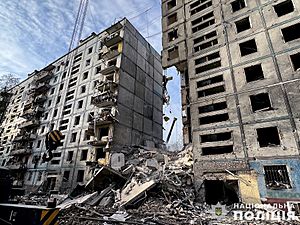
During the 2022 Russian invasion of Ukraine, Russian forces took control of the southern part of the region. They fought battles in Melitopol and Enerhodar. Ukrainian forces also attacked and damaged Russian ships in the port of Berdiansk. As of May 2022, Ukraine still controls the northern parts of the region, including the capital city, Zaporizhzhia.
In July 2022, countries like The Czech Republic, Finland, and Sweden promised to help rebuild the Zaporizhzhia region.
From September 23 to 27, 2022, Russia held a vote in the occupied areas of Zaporizhzhia and Kherson. They claimed these areas wanted to join Russia. Most countries see these votes as illegal. On September 30, Russian President Vladimir Putin announced the takeover of Zaporizhzhia Oblast and three other Ukrainian regions. At that time, Russia only controlled about 70% of Zaporizhzhia Oblast. The United Nations later passed a resolution asking countries not to recognize this takeover. They also demanded that Russia leave Ukraine.
Interesting Places to Visit
Several important sites in Zaporizhzhia Oblast were nominated for the Seven Wonders of Ukraine.
- Kamyana Mohyla: This is a prehistoric "Stone Tomb" site and museum.
- Khortytsia: This is a large island in the Dnieper River.
- Dniprostroy: This is a powerful hydroelectric power station.
How the Region is Divided
The Zaporizhzhia Oblast has changed how it is divided over time. Before 2020, it had 20 smaller areas called raions (districts). There were also 5 cities that reported directly to the regional government. These cities were Berdiansk, Enerhodar, Melitopol, Tokmak, and Zaporizhzhia.
After reforms in 2020, the oblast is now divided into just five new raions. These new raions include the cities that used to report directly to the regional government.
| Name | Ukrainian name | Area (km2) |
Population estimate 2021 |
Admin. center |
|---|---|---|---|---|
| Berdjans'kyj Raion | Бердянський район | 4,456 | 179,118 | Berdyansk |
| Melitopols'kyj Raion | Мелітопольський район | 6,962 | 280,816 | Melitopol |
| Polohivs'kyj Raion | Пологівський район | 6,767 | 167,060 | Polohy |
| Vasylivs'kyj Raion | Василівський район | 4,295 | 184,224 | Vasylivka |
| Zaporiz'kyj Raion | Запорізький район | 4,693 | 855,297 | Zaporizhzhia |
People of Zaporizhzhia Oblast
According to the 2001 Ukrainian Census, the population of the region was 1,929,171. Most people (70.8%) identified as Ukrainians. About 24.7% were Russians. Other groups included Bulgarians (1.4%) and Belarusians (0.7%). Almost half of the people (48.2%) said Russian was their first language.
The average age of people in the region in 2013 was 41.2 years. For males, it was 37.5 years, and for females, it was 44.8 years.
Education in Zaporizhzhia Oblast
In 2001, there were 679 daytime and 11 evening state schools. About 271,400 students attended these schools. There are also special schools for talented children, like classical schools and lyceums. Many children also take part in after-school activities. They can join creative centers, science clubs, and sports teams.
A special program called the Small Academy of Science helps young people explore different subjects. Students work with scientists from universities. The Zaporizhzhia team even won first place in a national contest.
Most schools use the Ukrainian language. However, there are also schools where Russian is taught. There is a large Jewish school in Zaporizhzhia and smaller ones elsewhere. A Ukrainian-Bulgarian Lyceum is in the Primorsky district. In some rural areas, Greek, Czech, and Bulgarian languages are popular. Students can also learn other languages like Hebrew, Yiddish, German, and Polish.
The region also has 42 vocational schools. These schools train students for jobs in local industries. They offer over 100 different specialties. Vocational schools also help unemployed people learn new skills.
For higher education, there are 25 technical colleges and 8 universities. These include the Zaporizhzhia Polytechnic, Medical University, and Institute of Law in Zaporizhzhia City. There are also universities in Melitopol and Berdiansk. Over 65,000 students attend higher education in the region. Many professors hold advanced degrees. Zaporizhzhia City is a major center for international students in Ukraine.
Two small planets have been named after Ukrainians from Zaporizhzhia Oblast. These are 5936 Khadzhinov and 19082 Vikchernov. They were named to honor people who made important contributions to science and education.
Economy of the Region
Zaporizhzhia Oblast is an important economic area in Ukraine. In 2016, its total economic output was about 104.3 billion ₴. This placed it 9th among all regions in Ukraine. The region's economy contributes about 4.4% to Ukraine's total economic output.
The main economic activities in the region are:
- Industry: This includes factories, electricity, gas, and air conditioning. It makes up 41% of the region's economy.
- Agriculture, forestry, and fisheries: Farming and related activities make up 13.9%.
- Wholesale and retail trade: Buying and selling goods accounts for 10.4%.
- Real estate: Deals involving property make up 6%.
See also
 In Spanish: Óblast de Zaporiyia para niños
In Spanish: Óblast de Zaporiyia para niños



